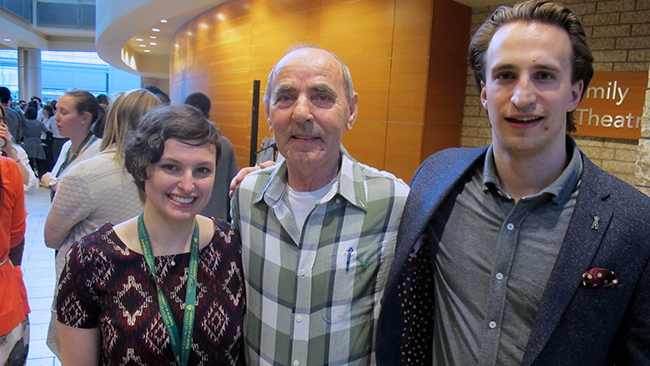
Medical students Emily King and Todd Radostits with their patient mentor David Aitken
David Aitken explores a room filled with art, with a gleam in his eyes and a smile on his face. There are no works of Picasso, Rembrandt or Jackson Pollock in sight, but for Aitken, what he sees is just as inspiring.
"It's beautiful, isn't it? I was waiting to see what they did and I am really impressed."
The artwork, more than 80 pieces in all, was created by medical students in the University of Alberta's MD program. Over the past two years, the medical students have been paired with patient mentors suffering from chronic illness to gain a better understanding of the experience of going through the health-care system. The artwork is the culmination of that two-year experience-a reflection of what the students have learned from their patient mentors about their journey. Aitken was one of the patient mentors, paired with two students just months after receiving a double lung transplant.
"I wanted to be involved because I can contribute," says Aitken. "I was fortunate to have the transplant. You can't ask for more than that, so if I could give back in any way, I was happy to do it. I mean, they are the future of medicine, aren't they?"
The innovative program pairing medical students with patient mentors is named the Patient Immersion Experience. It was first launched in the U of A's MD program in the 2013-2014 school year as a mandatory component of a physicianship course. Since then, medical students in the Faculty of Medicine & Dentistry have fully embraced it.
"When I first heard about the program I was pretty excited about it," says Emily King, a second-year medical student. "It's one of a kind in Canada and it's a unique opportunity to get to interact with a patient and to learn from their experience in the health-care system."
Over the course of two years, the students complete several home visits with their patient mentors and accompany them to one medical appointment. The goal is to help the students see the medical system through a patient's eyes. They become immersed in what it is like to be a patient living with chronic illness and to experience the impact it has on their life, identity and family dynamics.
The experience also informs the students' education in other areas of the physicianship course. The students are asked to reflect, through writing and discussion, on many key features of the doctor-patient relationship based on what they have learned from their mentors. For example, they look at the effect a physician's communication of a diagnosis had on their mentor, and in turn are asked to use this information when practising in their schooling how to communicate difficult information to patients.
Tracey Hillier, associate dean, curriculum, of the MD program, says, "We are hoping to create opportunities for students to really understand the patient perspective so that, as they continue in their training and future practice, they will have lasting empathy for all patients they will interact with."
The Patient Immersion Experience is also supported by the faculty's Arts & Humanities in Health & Medicine program. As of this spring, 165 medical students have become the first to complete it, creating interpretive projects including paintings, sculptures and musical performances. Pamela Brett-MacLean, director of the Arts & Humanities in Health & Medicine program, says the projects demonstrate a broad range of creative and compassionate insights and understanding.
"They capture a sense of heightened awareness and connectedness, which benefitted both the students and their mentors. Many of the projects were created for the patient mentors as gifts of thanks."
Hillier says the faculty is closely watching how the program affects students over the course of the two years, and early returns have been promising.
"I think the students have really internalized the patient illness experience," says Hillier. "They are amazing and their creativity and effort never ceases to amaze me. They have all shown tremendous effort."
Hillier says as the program grows, she hopes more patients hear of it and decide to become a volunteer. After going through the experience, Aitken couldn't agree more.
"How lucky and fortunate I am to be a part of [the medical students'] education in a small way," he says. "I want others to do the same thing. I think we owe it to the future."
As for King, she says being part of the program has been enlightening. She often thinks about her patient mentor while in class.
"He's been quite influential in my development as a student and a future physician. So I think that as I continue in my education, I will continue to reflect back on my time with him."
King adds that many students have formed lasting bonds with their patient mentors.
"I know that a lot of the patient mentors have expressed that they would like to come to our graduation. I think that's a testament to how strong some of these relationships are."
Close to 20 of the students' artworks are currently on display as part of the Art + Medicine: The Human Touch exhibit in the John W. Scott Health Sciences Library, an exhibit which is open to the public through April 10, 2015.